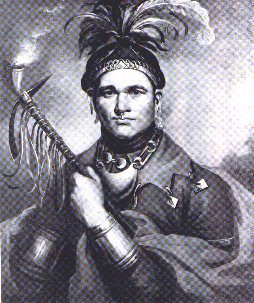|
In reference to the personal appearance of Cornplanter at the close of his life, a writer in the Democratic Arch,(Venango Co.,) says:
"
I once saw the aged and venerable chief, and had an interesting
interview with him about a year and a half before his death. I thought
of many things when seated near him, beneath the wide spreading shade
of an old Sycamore, on the banks of the Allegheny - many things to ask
him - the scenes of the revolution, the generals that fought its
battles and conquered the Indians, his tribe, the Six Nations and
himself. He was constitutionally sedate, was never observed to smile,
much less to indulge in the 'luxury of a laugh.' When I saw him, he
estimated his age to be over 100 years. I think 103 was about his
reckoning of it. This would make him near 105 years old at the time I
speak of. Mr. John Struthers, of Ohio, told me, some years since, that
he had seen him near 50 years ago, and at that period he was about his
height - viz: 6 feet 1 inch. Time and hardship had made dreadful
impressions upon that ancient form. The chest was sunken, and his
shoulders were drawn forward, making the upper part of his body
resemble a trough. His limbs had lost their size and become crooked.
His feet, too, (for he had taken off his moccasins,) were deformed and
haggard by injury. I would say that most of the fingers on one hand
were useless; the sinews had been severed by a blow of the tomahawk or
scalping knife. How I longed to ask him what scene of blood and strife
had thus stamped the enduring evidence of its existence upon his
person! But to have done so would, in all probability, have put an end
to further conversation on any subject, the information desired would
certainly not have been received, and I had to forego my curiosity. He
had but one eye, and even the socket of the lost organ was hid by the
overhanging brow resting upon the high cheekbone. His remaining eye was
of the brightest and blackest hue. Never have I seen one, in young or
old, that equalled its brilliancy. Perhaps it had borrowed lustre from
the eternal darkness that rested on its neighboring orb. His ears had
been dressed in the Indian mode: all but the outside ring had been cut
away. On one ear this ring had been torn asunder near the top, and hung
down his neck like a useless rag. He had a full head of hair, white as
the 'driven snow,' which covered a head of ample dimensions and
admirable shape. His face was not swarthy; but this may be accounted
for from the fact, also, that he was but half Indian. He told me that
he had been at Franklin more than 80 years before the period of our
conversation, on his passage down the Ohio and Mississippi with the
warriors of his tribe, on some expedition against the Creeks and
Osages. He had long been a man of peace, and I believe his great
characteristics were humanity and truth. It is said that Brant and
Cornplanter were never friends after the massacre of Cherry Valley.
Some have alleged; because the Wyoming massacre was perpetuated by the
Senecas, that Cornplanter was there. Of the justice of this suspicion
there are many reasons for doubt. It is certain that he was not the
chief of the Senecas at that time: the name of the chief in that
expedition was Ge-en-quah-toh, or He-goes-in-the smoke. As he stood
before me, the ancient chief in ruins, how forcibly was I struck with
the truth of the beautiful figure of the old aboriginal chieftain, who,
in describing himself, said he was "like an aged hemlock dead at the top, and whose branches alone were green.' After
more than one hundred years of most varied life - of strife, of danger
and of peace - he at last slumbers in deep repose, on the banks of his
own beloved Allegheny."
|








